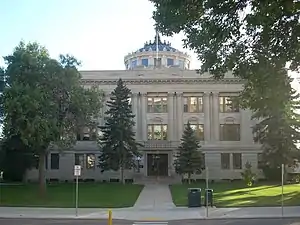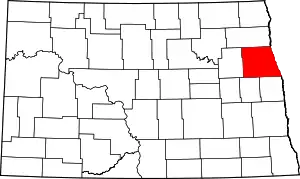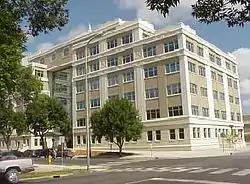Grand Forks County, North Dakota
Grand Forks County is a county in the U.S. state of North Dakota. As of the 2020 census, its population was 73,170,[1] making it the third-most populous county in North Dakota. Its county seat and largest community is Grand Forks.[2]
Grand Forks County | |
|---|---|
 | |
 Location within the U.S. state of North Dakota | |
 North Dakota's location within the U.S. | |
| Coordinates: 47°55′N 97°27′W | |
| Country | |
| State | |
| Founded | January 4, 1873 (created) March 2, 1875 (organized) |
| Seat | Grand Forks |
| Largest city | Grand Forks |
| Area | |
| • Total | 1,440 sq mi (3,700 km2) |
| • Land | 1,436 sq mi (3,720 km2) |
| • Water | 3.1 sq mi (8 km2) 0.2% |
| Population (2020) | |
| • Total | 73,170 |
| • Estimate (2022) | 72,413 |
| • Density | 51/sq mi (20/km2) |
| Time zone | UTC−6 (Central) |
| • Summer (DST) | UTC−5 (CDT) |
| Congressional district | At-large |
| Website | www |
History
Using territory annexed from Pembina County, the Dakota Territory legislature created Grand Forks County on January 4, 1873. Its governing structure was not established at that time, nor was the territory attached to another county for administrative and judicial purposes. The government was organized on March 2, 1875.
The county's boundaries were altered in 1875, 1881, and 1883. It has retained its present boundary since 1883.[3][4]
Grand Forks County is included in the Grand Forks, ND-MN Metropolitan Statistical Area.
Geography
Grand Forks County lies on the east side of North Dakota. Its eastern boundary line abuts the west boundary line of the state of Minnesota (across the Red River). The Red River flows northward along the county's east border, on its way to Lake Winnipeg and Hudson Bay. The Forest River flows eastward and northward across the upper western part of the county.
The terrain of Grand Forks County consists of low rolling hills, devoted to agriculture except around urban areas.[5] The terrain slopes to the north and east; its highest point is a hill at its southwestern corner, at 1,450 ft (440 m) ASL.[6] The county has a total area of 1,440 square miles (3,700 km2), of which 1,436 square miles (3,720 km2) is land and 3.1 square miles (8.0 km2) (0.2%) is water.[7]
The University of North Dakota has established a Field Biology Station on Forest River, at the county's northern border. In 2013 it partnered with ND Game & Fish Department to establish a 160-acre (0.65 km2) wildlife management area at the station, to monitor whitetail deer activity in the forest.[8] The field station is tasked with identifying plants native and endemic to the area. A total of 498 plants have been collected at the Forest River Biology Station and Wildlife Management Area.[9]
Major highways
Adjacent counties
- Walsh County - north
- Marshall County, Minnesota - northeast
- Polk County, Minnesota - east
- Traill County - southeast
- Steele County - southwest
- Nelson County - west
Protected areas[5]
- Forest River Biology Station/Wildlife Management Area
- Grand Forks County Larimore Dam Recreation Area
- Kellys Slough National Wildlife Refuge
- Little Goose National Wildlife Refuge
- Prairie Chicken State Game Management Area
- Turtle River State Park
Lakes[5]
- Fordville Dam
- Larimore Dam
- Smith Lakes
Demographics
| Census | Pop. | Note | %± |
|---|---|---|---|
| 1880 | 6,248 | — | |
| 1890 | 18,357 | 193.8% | |
| 1900 | 24,459 | 33.2% | |
| 1910 | 27,888 | 14.0% | |
| 1920 | 28,795 | 3.3% | |
| 1930 | 31,956 | 11.0% | |
| 1940 | 34,518 | 8.0% | |
| 1950 | 39,448 | 14.3% | |
| 1960 | 48,677 | 23.4% | |
| 1970 | 61,102 | 25.5% | |
| 1980 | 66,100 | 8.2% | |
| 1990 | 70,683 | 6.9% | |
| 2000 | 66,109 | −6.5% | |
| 2010 | 66,861 | 1.1% | |
| 2020 | 73,170 | 9.4% | |
| 2022 (est.) | 72,413 | [10] | −1.0% |
| U.S. Decennial Census[11] 1790-1960[12] 1900-1990[13] 1990-2000[14] 2010-2020[1] | |||
2020 census
As of the census of 2020, there were 73,170 people, 33,428 households, and 31,152 families in the county.
2010 census
As of the census of 2010, there were 66,861 people, 27,417 households, and 15,215 families in the county. The population density was 46.5 inhabitants per square mile (18.0/km2). There were 29,344 housing units at an average density of 20.4 units per square mile (7.9/km2). The racial makeup of the county was 90.3% white, 2.5% American Indian, 2.0% black or African American, 1.9% Asian, 0.1% Pacific islander, 0.8% from other races, and 2.4% from two or more races. Those of Hispanic or Latino origin made up 2.9% of the population. In terms of ancestry, 34.1% were German, 33.8% were Norwegian, 9.5% were Irish, 5.8% were Polish, 5.3% were English, and 2.9% were American.
Of the 27,417 households, 26.6% had children under the age of 18 living with them, 42.8% were married couples living together, 9.1% had a female householder with no husband present, 44.5% were non-families, and 32.1% of all households were made up of individuals. The average household size was 2.28 and the average family size was 2.91. The median age was 29.7 years.
The median income for a household in the county was $44,242 and the median income for a family was $65,804. Males had a median income of $40,622 versus $31,633 for females. The per capita income for the county was $24,276. About 8.2% of families and 17.5% of the population were below the poverty line, including 15.6% of those under age 18 and 10.3% of those age 65 or over.
Population by decade

Communities

Cities
Census-designated places
Other communities[5]
Townships
- Agnes
- Allendale
- Americus
- Arvilla
- Avon
- Bentru
- Blooming
- Brenna
- Chester
- Elkmount
- Elm Grove
- Fairfield
- Falconer
- Ferry
- Gilby
- Grace
- Grand Forks
- Hegton
- Inkster
- Johnstown
- Lakeville
- Larimore
- Levant
- Lind
- Logan Center
- Loretta
- Mekinock
- Michigan
- Moraine
- Niagara
- Northwood
- Oakville
- Pleasant View
- Plymouth
- Rye
- Strabane
- Turtle River
- Union
- Walle
- Washington
- Wheatfield
| Range 56 | Range 55 | Range 54 | Range 53 | Range 52 | Range 51 | Range 50 | Range 49 | |
|---|---|---|---|---|---|---|---|---|
| Township 154 | Elkmount | Inkster | Strabane | Johnstown | Levant | Turtle River | Turte River | |
| Township 153 | Plymouth | Agnes | Wheatfield | Gilby | Lakeville | Ferry | Ferry | |
| Township 152 | Niagara | Elm Grove | Hegton | Mekinock | Blooming | Rye | Falconer | |
| Township 151 | Moraine | Larimore | Arvilla | Chester | Oakville | Brenna | Grand Forks | |
| Township 150 | Logan Center | Grace | Avon | Pleasant View | Fairfield | Allendale | Walle | Walle |
| Township 149 | Loretta | Lind | Northwood | Washington | Union | Micbigan | Americus | Bentru |
Politics
Like all parts of North Dakota other than areas with reservations, Grand Forks County voters historically and currently vote Republican at the presidential level. In only one national election since 1964 has the county selected the Democratic Party candidate. However, the large student population has kept margins closer in recent elections.
| Year | Republican | Democratic | Third party | |||
|---|---|---|---|---|---|---|
| No. | % | No. | % | No. | % | |
| 2020 | 16,987 | 54.85% | 12,880 | 41.59% | 1,105 | 3.57% |
| 2016 | 16,340 | 53.81% | 10,851 | 35.74% | 3,174 | 10.45% |
| 2012 | 15,060 | 50.15% | 14,032 | 46.73% | 937 | 3.12% |
| 2008 | 14,520 | 46.34% | 16,104 | 51.40% | 709 | 2.26% |
| 2004 | 17,298 | 56.77% | 12,646 | 41.50% | 526 | 1.73% |
| 2000 | 15,875 | 55.93% | 10,593 | 37.32% | 1,917 | 6.75% |
| 1996 | 11,606 | 44.92% | 11,376 | 44.03% | 2,854 | 11.05% |
| 1992 | 13,705 | 44.06% | 10,930 | 35.14% | 6,469 | 20.80% |
| 1988 | 14,801 | 53.76% | 12,494 | 45.38% | 236 | 0.86% |
| 1984 | 15,898 | 60.70% | 10,050 | 38.37% | 243 | 0.93% |
| 1980 | 14,257 | 57.65% | 6,997 | 28.29% | 3,477 | 14.06% |
| 1976 | 13,820 | 52.71% | 11,545 | 44.03% | 853 | 3.25% |
| 1972 | 13,361 | 56.92% | 9,416 | 40.11% | 698 | 2.97% |
| 1968 | 9,802 | 52.00% | 7,695 | 40.82% | 1,352 | 7.17% |
| 1964 | 7,367 | 40.53% | 10,740 | 59.09% | 68 | 0.37% |
| 1960 | 10,997 | 56.85% | 8,341 | 43.12% | 5 | 0.03% |
| 1956 | 10,289 | 62.17% | 6,231 | 37.65% | 30 | 0.18% |
| 1952 | 10,939 | 65.65% | 5,639 | 33.84% | 84 | 0.50% |
| 1948 | 6,374 | 46.23% | 6,996 | 50.74% | 419 | 3.04% |
| 1944 | 5,668 | 42.19% | 7,707 | 57.37% | 59 | 0.44% |
| 1940 | 7,043 | 45.42% | 8,396 | 54.15% | 67 | 0.43% |
| 1936 | 4,312 | 29.64% | 9,222 | 63.39% | 1,015 | 6.98% |
| 1932 | 5,090 | 39.46% | 7,579 | 58.75% | 231 | 1.79% |
| 1928 | 8,024 | 64.86% | 4,300 | 34.76% | 47 | 0.38% |
| 1924 | 6,690 | 62.81% | 943 | 8.85% | 3,018 | 28.34% |
| 1920 | 7,646 | 74.00% | 2,527 | 24.46% | 159 | 1.54% |
| 1916 | 2,159 | 41.94% | 2,814 | 54.66% | 175 | 3.40% |
| 1912 | 955 | 23.88% | 1,492 | 37.31% | 1,552 | 38.81% |
| 1908 | 2,740 | 57.41% | 1,750 | 36.66% | 283 | 5.93% |
| 1904 | 2,807 | 73.16% | 828 | 21.58% | 202 | 5.26% |
| 1900 | 2,603 | 61.33% | 1,532 | 36.10% | 109 | 2.57% |
References
- "State & County QuickFacts". United States Census Bureau. Retrieved March 30, 2023.
- "Find a County". National Association of Counties. Archived from the original on May 31, 2011. Retrieved June 7, 2011.
- "Dakota Territory, South Dakota, and North Dakota: Individual County Chronologies". Dakota Territory Atlas of Historical County Boundaries. The Newberry Library. 2006. Archived from the original on April 2, 2018. Retrieved February 3, 2015.
- "County History". North Dakota.gov. The State of North Dakota. Archived from the original on February 2, 2015. Retrieved February 3, 2015.
- Grand Forks County ND Google Maps (accessed February 19, 2019)
- ""Find an Altitude/Grand Forks County ND" Google Maps (accessed February 19, 2019)". Archived from the original on May 21, 2019. Retrieved February 19, 2019.
- "2010 Census Gazetteer Files". United States Census Bureau. August 22, 2012. Archived from the original on January 29, 2015. Retrieved January 28, 2015.
- "Grand Forks Herald" (June 22, 2017)
- The checklist of vascular plants of Forest River Biology Station and Wildlife Management Area, Grand Forks county, North Dakota
- "Annual Estimates of the Resident Population for Counties: April 1, 2020 to July 1, 2022". Retrieved March 30, 2023.
- "US Decennial Census". United States Census Bureau. Retrieved January 28, 2015.
- "Historical Census Browser". University of Virginia Library. Retrieved January 28, 2015.
- Forstall, Richard L., ed. (March 27, 1995). "Population of Counties by Decennial Census: 1900 to 1990". United States Census Bureau. Retrieved January 28, 2015.
- "Census 2000 PHC-T-4. Ranking Tables for Counties: 1990 and 2000" (PDF). United States Census Bureau. April 2, 2001. Archived (PDF) from the original on March 27, 2010. Retrieved January 28, 2015.
- "Earth Point".
- Leip, David. "Atlas of US Presidential Elections". uselectionatlas.org. Retrieved April 12, 2018.
- The leading "other" candidate, Progressive Theodore Roosevelt, received 1,327 votes, while Socialist candidate Eugene Debs received 180 votes, Prohibition candidate Eugene Chafin received 45 votes.
External links
- Grand Forks County official website
- Grand Forks County maps, Sheet 1 (northern) and Sheet 2 (southern), North Dakota DOT